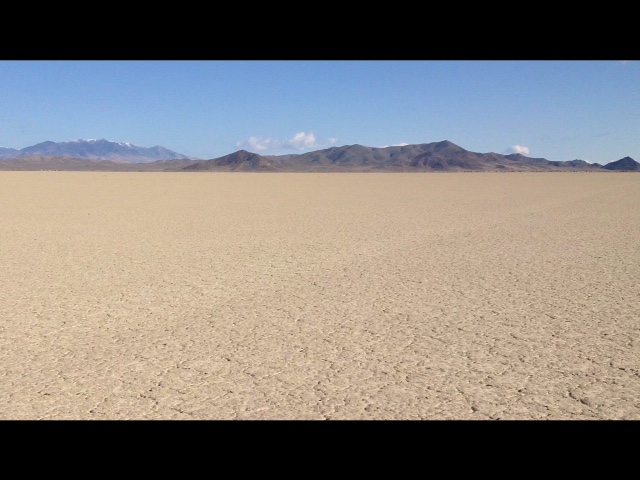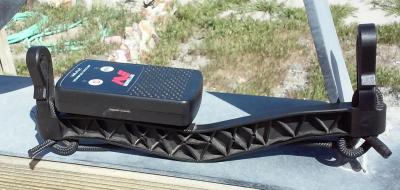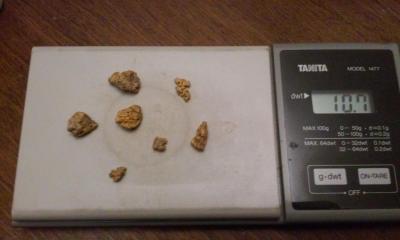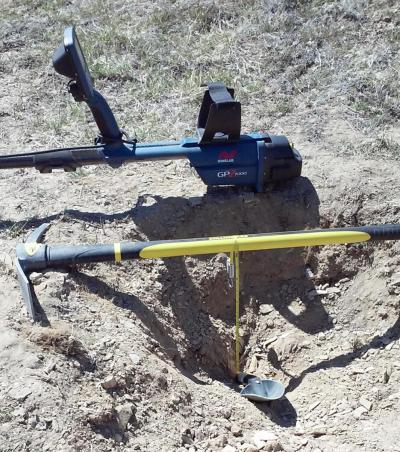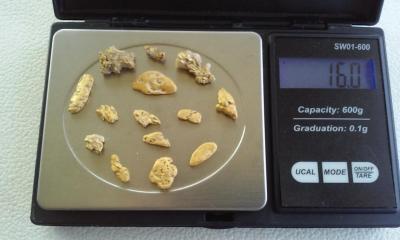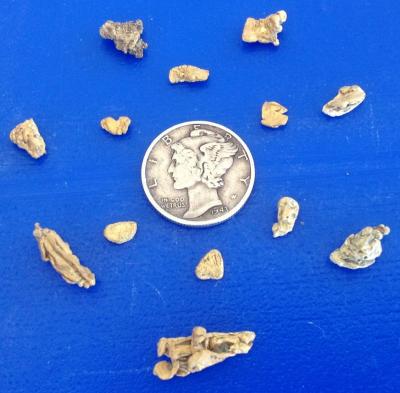-
Posts
1,185 -
Joined
-
Last visited
Content Type
Forums
Detector Prospector Home
Detector Database
Downloads
Everything posted by Lunk
-

Huge Problem With Wireless Module For GPZ 7000
Lunk replied to Steve Herschbach's topic in Minelab Metal Detectors
I took my WM-12 out of its clip harness and affixed it to the cross-piece of the pro-swing harness; that way the speaker is pointed directly at my face and is centered so the sound hits both ears equally. And the industrial strengh velcro used prevents it from accidentally coming off. -
No worries: "The GPZ remembers its GB position when you go from one gold mode to another, however from a fresh power on state you need to perform the GB procedure as described in the White Paper to be sure the GB is accurate, this procedure is recommended for every Gold mode you intend to use in that session." JP So just perform the initial GB procedure in each Gold Mode and Ground Type at power on and you're good to go for the rest of the session. A little time consuming, but it saves time and trouble by not having to re-ground balance every time you change modes.
-
Good post Jason. I've been experimenting along the same lines, and that's one of the things I like about the many timing options on the GPX series; by switching between certain timings it is possible to differentiate real metal targets from hot rocks and ground noises. The several Gold Mode and Ground Type combinations of the Zed can potentially be used to do the same thing. I tried every possible combination on a solid 28 gram nugget and all but one gave a low/high respoonse...the Severe Ground Type gave a high/low response. Since Severe should eliminate most if not all ground noise, when getting a strong low/high in Normal or Difficult Ground Type modes and then switching to Severe still gives a strong low/high or a high low, better get digging!
-
I totally agree with JP on his Audio Smoothing tip, and I've been experimenting lately on additional ways of avoiding the necessity of switching from Normal to Difficult Ground Type; when in Normal and the ground becomes too noisy for High Yield Gold Mode even at low sensitivity, changing to General often solves the problem and the sensitivity can be increased a couple points to compensate for the slight loss in sensitivity to small gold. If the ground is still too bad, switching the Gold Mode yet again to Extra Deep and increasing the sensitivity appears to still have a noticeable amount of performance over the Difficult Ground Type, and has been able to eliminate extremely variable ground noise.
-

Minelab Video - GPZ 7000 Ground Type
Lunk replied to Steve Herschbach's topic in Minelab Metal Detectors
I heartily agree with Jasong, the same has been my experience as well. -
Another 10 grams of chunky golden Zedness today, again in a spot that was cleaned out by the GPX 5000...I am REALLY liking this ZVT!
-
Yes, the same audio settings work great with all combinations of gold modes and ground types.
-
Nice Strick, looks like you're well on your way to becoming a Zedhead!
-
WTG Russ, looks like you've got the hang of your Zed!
-
WTG Steve. One nugget is better than none, but it's all about having fun.
-
I decided to take the mighty Zed into an old patch where I haven't been able to scare up even a crumb for the last few years. Some large deep nuggets were originally found there, so I thought I'd try it in the General gold mode and Normal ground type settings. With the sensitivity at 10 there were a few ground noises, but nothing too bad. The first pass through the patch yielded the same results as before...nothing. So then I went over the same ground again, but this time I shifted the Zed into hyperdrive by switching to the High Yield gold mode, and suddenly that elusive gold that I knew was there lit up like the Fourth of July! It was literally like a new patch with several nuggets within a ten foot stretch in one area, or two nuggets in one hole in another. Nothing real big was found, but everything was at depth. The one that really blew me away was a thin four-tenths of a gram nugget at a measured twelve inches that sounded great on top. Though the sensitivity had to be cut back to 8 because of ground noise, the amount of performance was staggering; a fat half ounce between 13 nuggets in just a couple hours, all on a patch that had no gold left...I'll definitely have to go back and grid the entire patch now!
-
Thanks Bill, and yes I will be training at the 3-day detector training at Rye Patch...see you there!
-
WTG Lucky!
-
Hey, how did you know I have more than one poke bottle?! I have yet to use the wide-mouthed coffee can poke...let alone the 50 gallon drum poke...Indeed though Rick, for a machine with a simplified amount of settings (compared to the GPX range) the Zed's audio functions still provide many different combinations and perrmutations that can surprisingly affect the overall performance of the machine; to me, experimenting in such a situation is a must to squeeze out maximum performance. Mitchel: Sorry I missed you; please just shoot me a PM next time you'll be in the area and we'll hook up for a hunt.
-
After logging 200 hours behind the Zed pod and unearthing over an ounce of nuggety yellow goodness, I'd like to share my settings with my fellow forum members who would like to take them out for a spin. Since settings like the Gold Mode, Ground Type and Sensitivity are dependent on the local conditions where one is detecting, my focus here is mainly the audio settings. As some of you may know, my audio settings for the GPX range of detectors were very unconventional, and it is no different with the GPZ 7000; at first glance these settings may seem counter-intuitive, but give them a try because you may just be pleasantly surprised. Before getting into the settings proper, I want to mention that they are intended for use with the supplied WM-12 Wireless Module, utilizing its external speaker. I haven't tried it with headphones yet, so feel free to experiment if you use them. I noticed right away that the Zed's pre-set audio out of the box is extremely weak, especially on faint target signals. Using an aftermarket signal enhancer like JP's B&Z booster would work wonders for it, but I surmised that a $10,000 piece of technology would have some kickin' audio amplification and modulation, and the Zed certainly does have! It is VERY IMPORTANT to make the adjustments to the audio functions in the order that they are presented below: A key component to this audio setup is enhancing the signal via the Volume function, which controls the level of amplification of a target's audio response, relative to its signal strength, so we'll start there: adjust the Volume to 15. This will really amplify any faint signal from very small or deep targets. The next audio function is the Threshold Level, which we will adjust to 35. If the threshold level is set too high or too low, faint targets will be missed. A setting of 35 is optimum for this particular combination of audio settings. The Threshold Pitch setting is a matter of personal preference, so adjust it to a tone that is comfortable to your own hearing. I personally prefer a setting of 25, as it supplies a nice full tonal range from a booming bassy bottom through to a crisp, clean high tone when a target signal is encountered. The next function we will adjust is the Audio Smoothing: set it to High. This may seem counter-productive, but it is essential to getting the most distinct target response possible, nice and crisp. I learned this technique long ago from my mentor Larry Salee, a great detectorist whom some of you may remember from his famed "Zip-Zip" series of publications. This leads us on to the next function, Volume Limit, which sets the maximum loudness that a target can make; set too high, it can over-modulate or distort the external speaker and potentially damage your hearing, especially when using headphones. Turn it down to 1, and while swinging the coil over a large metal object such as your pick, gradually increase the setting until the sound is uncomfortably loud; then back it off until the sound is comfortable to listen to. For my hearing, a Volume Limit setting of 3 is perfect. In summary, here are my audio settings back to back: Volume: 15 Threshold Level: 35 Threshold Pitch: 25 Audio Smoothing: High Volume Limit: 3 This audio set-up works with any combination of Gold Mode and Ground Type settings, and is very stable in conjuction with a Sensitivity setting of anywhere from 8 to 15, depending on local conditions, and provides a pleasant, silky-smooth threshold while at the same time delivering a crisp, distinct target response. Please feel free to let me know what you think of these audio settings after giving them a go in your favorite goldfield or nugget patch, especially if you have the oportunity to compare them to your own settings on undisturbed, un-dug targets - preferably gold nuggets! Now for those of you interested, I'd also like to share my complete Zed settings for the greater Rye Patch region of northern Nevada; they handle the area's noisy, variable ground found in most nugget patches extremely well. In addition to the above audio settings, they are: Gold Mode: High Yield Ground Type: Difficult Sensitivity: 15 Ground Balance Mode: Auto Thanks for reading, and happy prospecting!
-
Six more grams of the good stuff recently, unearthed by the mighty Zed...the old patches are getting thin, time to go for a walkabout!
-
My favorite indicators are gold nuggets. Everything you ever want to know about the subject is covered in Chris Ralph's excellent book, "Fists Full of Gold".
-
WTG you two! Rick it was great running into you at C Punch in Lovelock. Looks like you've got your Zed dialed in pretty good; just got to get it over a nice fat one now...
-
The 6 gram nugget I dropped right there?
-
That's a bummer, B.B. Those Zed nuggets will be waiting for you...something to look forward to...best of luck!
-
Bada Bing, did you try JP's suggestion here: Sounds like there is a fair component of salt in your ground down that way, to get less salt signal try the General Xtra Deep/Difficult mode and increase the Gain/Sensitivity to compensate for signal response reduction. Best way to determine Salt is to lift the coil above knee height, if there's a strong signal as you bring the coil away up to knee height and above then salt is present. JP
-

GPZ 7000 Scores 4 in The One Hole *Update*
Lunk replied to aussiedigger's topic in Detector Prospector Forum
Beautiful, good job! -
WTG!

